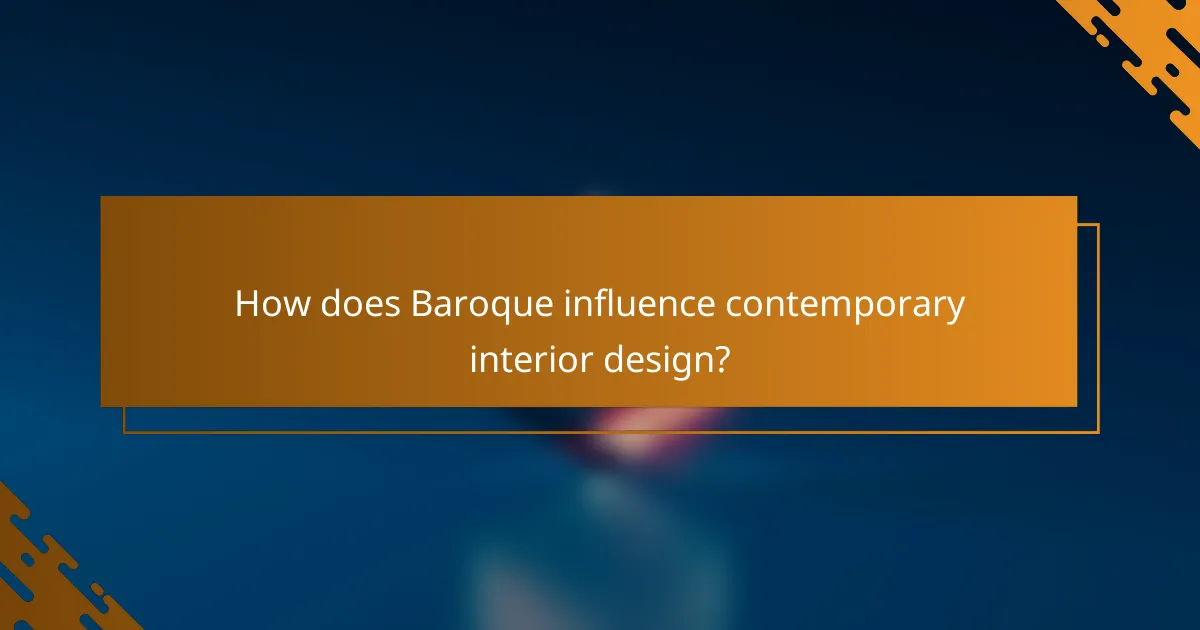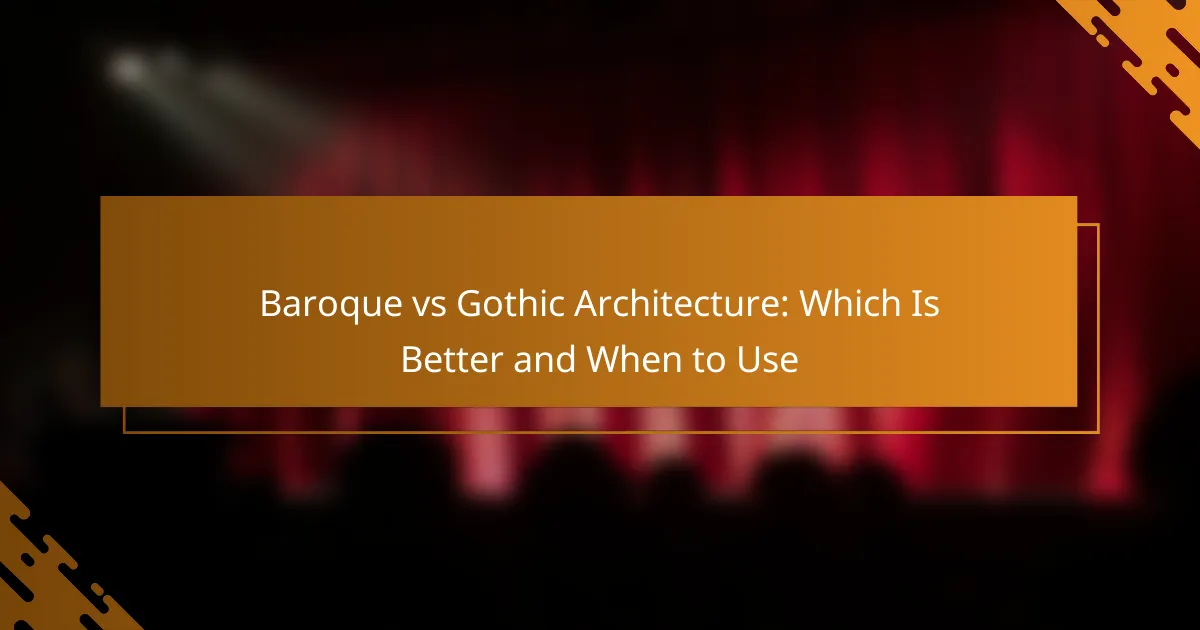The incorporation of Baroque elements into contemporary design creates a captivating blend of ornate details and modern functionality. By embracing the dramatic expressions, rich colors, and luxurious materials characteristic of the Baroque style, designers can evoke a sense of grandeur while maintaining a practical aesthetic. This fusion not only honors the historical significance of the Baroque period but also enriches modern spaces with depth and dynamism.

How to incorporate Baroque elements in modern design?
Incorporating Baroque elements into modern design involves blending ornate details, rich colors, dramatic lighting, luxurious materials, and symmetry. This fusion can create a striking aesthetic that pays homage to the grandeur of the Baroque period while remaining functional and contemporary.
Use of ornate details
Ornate details are a hallmark of Baroque design, characterized by intricate patterns, carvings, and embellishments. To incorporate these elements, consider using decorative moldings, elaborate furniture, or textiles with detailed embroidery. Aim for a balance; too many ornate features can overwhelm a space.
Examples include using a baroque-style mirror with intricate frames or selecting wallpaper that features elaborate motifs. These details add depth and interest to modern interiors without sacrificing functionality.
Integration of rich colors
Rich colors are essential in Baroque design, often featuring deep hues like burgundy, gold, and emerald. To effectively integrate these colors, choose a dominant shade for walls or large furniture pieces, complemented by accents in contrasting tones. This approach creates a luxurious atmosphere.
Consider using a dark accent wall paired with lighter furnishings or accessories in gold or brass to enhance the richness of the space. Be mindful of color balance to avoid a heavy or dark feeling in smaller rooms.
Incorporation of dramatic lighting
Dramatic lighting is crucial for highlighting Baroque elements and creating an inviting ambiance. Use statement chandeliers, wall sconces, or oversized lamps to draw attention and add a sense of grandeur. Layering different light sources can enhance the overall effect.
For instance, a grand chandelier can serve as a focal point in a dining room, while softer, warm lighting can create a cozy atmosphere. Ensure that lighting fixtures complement the ornate details and color palette of the space.
Utilization of luxurious materials
Luxurious materials such as velvet, silk, and marble are integral to Baroque design. Incorporate these materials through upholstery, drapery, or flooring to evoke a sense of opulence. Mixing textures can also add depth and interest to your design.
For example, a velvet sofa paired with silk cushions and a marble coffee table can create a sophisticated look. Be cautious with the quantity; too many luxurious materials can lead to a cluttered appearance.
Emphasis on symmetry
Symmetry is a key principle in Baroque design, creating a sense of balance and harmony. To emphasize symmetry, arrange furniture and decor in pairs or mirror images. This can be particularly effective in living rooms or entryways.
For instance, placing two identical armchairs opposite a central coffee table or using matching lamps on either side of a console table can enhance the overall aesthetic. Ensure that the symmetry aligns with the ornate details and color scheme for a cohesive look.

What are the key characteristics of Baroque style?
Baroque style is characterized by its dramatic expression, grandeur, and intricate details, often evoking emotion and movement. Key elements include exaggerated motion, contrast, and complex forms that create a sense of dynamism and depth.
Exaggerated motion
Exaggerated motion is a hallmark of Baroque style, aiming to convey a sense of action and energy. This is achieved through dynamic poses, swirling drapery, and compositions that draw the viewer’s eye along a path of movement.
In architecture, this can manifest in sweeping curves and expansive spaces that create a feeling of fluidity. Artists like Gian Lorenzo Bernini exemplified this in works such as the Ecstasy of Saint Teresa, where the figures seem to be caught in a moment of intense action.
Contrast and chiaroscuro
Contrast and chiaroscuro are essential techniques in Baroque art, emphasizing the interplay of light and shadow to enhance drama. This technique creates a three-dimensional effect, making figures appear more lifelike and engaging.
Artists like Caravaggio utilized chiaroscuro to highlight focal points in their compositions, guiding the viewer’s attention and evoking emotional responses. The stark contrasts in light not only add depth but also enhance the narrative quality of the artwork.
Complex forms and shapes
Complex forms and shapes define the Baroque aesthetic, moving away from the simplicity of earlier styles. This complexity is evident in the ornate details of sculptures, architecture, and paintings, which often feature intricate patterns and elaborate designs.
In architecture, Baroque buildings are characterized by their grand facades, elaborate columns, and intricate ornamentation. The use of curves and asymmetry contributes to a sense of movement and richness, inviting viewers to explore every detail.

How does Baroque influence contemporary interior design?
Baroque influences contemporary interior design by reintroducing dramatic aesthetics, intricate details, and a sense of grandeur. This style emphasizes bold contrasts, opulent materials, and a rich color palette, creating spaces that feel both luxurious and inviting.
Revival of classical motifs
Contemporary design often incorporates Baroque elements like ornate moldings, elaborate chandeliers, and rich textiles. These classical motifs serve as focal points, adding depth and character to modern spaces. For instance, a room might feature a contemporary sofa paired with a vintage Baroque-style mirror to create a striking visual contrast.
When selecting classical motifs, consider the balance between old and new. Too many ornate features can overwhelm a space, so aim for a few standout pieces that enhance the overall design without cluttering it.
Mixing modern and traditional elements
Combining modern and traditional elements is a hallmark of contemporary Baroque design. This approach allows for the creation of unique, personalized spaces that reflect individual tastes. For example, sleek furniture can be juxtaposed with traditional Baroque art or decorative accents to create an engaging contrast.
To achieve a harmonious blend, focus on color coordination and material consistency. Using a cohesive color palette can tie together disparate styles, while materials like velvet or gold accents can bridge the gap between contemporary and Baroque aesthetics.
Focus on craftsmanship
Baroque design emphasizes high-quality craftsmanship, which remains relevant in contemporary interiors. Investing in well-made furniture and decor not only enhances durability but also adds a sense of authenticity and luxury to a space. Look for pieces that showcase artisanal techniques, such as hand-carving or intricate upholstery.
When selecting items, prioritize craftsmanship over mass-produced alternatives. This not only supports local artisans but also ensures that your interior design reflects a commitment to quality and timeless elegance.

What are the best Baroque-inspired furniture pieces?
The best Baroque-inspired furniture pieces combine opulence with intricate craftsmanship, reflecting the grandeur of the Baroque period. Key elements include ornate designs, rich materials, and dramatic forms that can elevate contemporary interiors.
Baroque-style chairs
Baroque-style chairs are characterized by their elaborate carvings, luxurious upholstery, and bold shapes. Look for pieces with intricate details such as gilded accents, curved legs, and plush fabrics like velvet or brocade. These chairs often serve as statement pieces in a room, adding a touch of elegance and sophistication.
When selecting Baroque-style chairs, consider the scale of your space. Oversized chairs can dominate smaller rooms, while more compact designs can fit well in various settings. Aim for a balance between style and comfort, ensuring that the chair is not only visually striking but also functional.
Ornate mirrors
Ornate mirrors are essential in Baroque design, often featuring elaborate frames adorned with carvings, gold leaf, or intricate patterns. These mirrors not only serve a practical purpose but also act as decorative focal points that enhance the overall aesthetic of a room. Consider placing them in entryways or above mantels to maximize their impact.
When choosing an ornate mirror, pay attention to the frame’s details and finish. A well-crafted mirror can reflect light and create an illusion of space, making it a valuable addition to both large and small rooms. Ensure that the style of the mirror complements your existing decor for a cohesive look.
Elaborate chandeliers
Elaborate chandeliers are iconic elements of Baroque-inspired interiors, known for their grandeur and intricate designs. These lighting fixtures often feature multiple arms, crystal embellishments, and a mix of materials that catch the eye. A well-placed chandelier can serve as a stunning centerpiece in dining rooms or entryways.
When selecting a chandelier, consider the height of your ceilings and the scale of the room. A larger chandelier can create a dramatic effect in spacious areas, while smaller designs may be more suitable for intimate settings. Ensure that the lighting complements the overall style of your home while providing adequate illumination.

How to choose Baroque decor for a home?
Choosing Baroque decor for a home involves selecting ornate, dramatic elements that reflect the grandeur of the style while ensuring they fit harmoniously within your space. Focus on key features such as rich colors, intricate patterns, and luxurious materials to create an authentic Baroque atmosphere.
Consider room size and layout
When incorporating Baroque decor, the size and layout of your room are crucial. Larger spaces can accommodate bold, elaborate pieces like grand chandeliers and oversized furniture, while smaller rooms may benefit from more subtle accents to avoid overwhelming the space.
For instance, in a spacious living room, a large, ornate mirror can serve as a focal point, while in a compact area, consider smaller decorative items like Baroque-style picture frames or accent pillows to maintain the style without crowding.
Balance with minimalist elements
To prevent a cluttered look, balance Baroque decor with minimalist elements. This approach allows the ornate features to stand out while creating a sense of calm in the overall design. Pairing a lavish Baroque sofa with a simple, modern coffee table can achieve this effect.
Additionally, using neutral colors for walls and larger furniture pieces can help highlight the rich textures and colors typical of Baroque design. Aim for a harmonious blend where the opulence of Baroque decor is complemented by clean lines and understated accessories.



